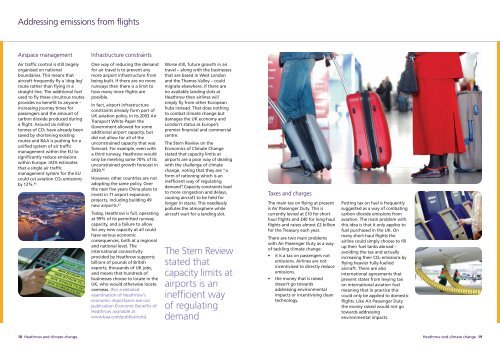Heathrow Airport's emissions reductions efforts - Airports Council ...
Heathrow Airport's emissions reductions efforts - Airports Council ...
Heathrow Airport's emissions reductions efforts - Airports Council ...
Create successful ePaper yourself
Turn your PDF publications into a flip-book with our unique Google optimized e-Paper software.
The facts about climate changeWhich gases aregreenhouse gases?Carbon Dioxide (CO2) is theprimary concern. The humancontribution of carbon dioxide inthe atmosphere comes primarilyfrom burning fossil fuels. Today itaccounts for about 380 of everymillion molecules in theatmosphere, or 380 parts permillion (ppm). Before theindustrial revolution atmosphericlevels of CO2 had held steady forcenturies at around 270 – 280ppm, but the number is currentlyclimbing by an average of 1-2 ppma year. There is disagreementabout the level at which CO2would need to be stabilised toavoid the worst effects of climatechange. The Government has atarget of stabilising CO2 at 550ppm 16 , but some organisationsestimate that a level as low as450 ppm might be necessary. 17It does not matter where in theworld carbon dioxide is produced– it has the same effect on theatmosphere. 18 A molecule of CO2stays in the atmosphere for abouta century. 19Methane (CH4) is 23 times morepowerful as a greenhouse gasthan carbon dioxide but isprevalent in smaller quantities. 20Methane molecules make up lessthan 2 ppm of the atmospherebut have risen by 150%compared to pre-industriallevels. 21 The main sources of manmademethane are fromdeforestation, decomposition ofwaste and rice and cattleproduction. 22Nitrous Oxide (N2O) is anagricultural and industrial byproduct.23 It is much more scarcethan carbon dioxide in theEarth’s atmosphere – only havingconcentrations of about 300 partsper billion – but is 296 times morepowerful as a greenhouse gasthan CO2. 24Other gases that influence globalwarming include ozone, watervapour, and some haloalkanessuch as hydrofluorocarbons(HFCs). Each is thought to have alesser effect than carbon dioxide– some are powerful greenhousegases but exist in small quantities,others are more prevalent in theatmosphere but are muchweaker. 25If you take into account therelative power of each of thesegases and the amount of eachgas that is produced by manmadeactivities it is possible toestimate the overall globalwarming potential of each gas.The World Resources Instituteestimates that carbon dioxide isresponsible for 77% of manmadeglobal greenhouse gas<strong>emissions</strong>, methane 14%,nitrous oxide 8%, and othergases 1%. 26Which countries are mostresponsible for greenhousegas <strong>emissions</strong> today?% of global <strong>emissions</strong>United States 20.6China 14.8Russia 5.7India 5.5Japan 4.0Germany 2.9Brazil 2.5Canada 2.1United Kingdom 2.0Italy 1.6Emissions per capita(tonnes of carbon equivalentper person)Qatar 18.5UAE 10.1Kuwait 9.5Bahrain 7.0Australia 6.8United States 6.8Canada 6.3New Zealand 5.8Brunei 5.8Luxembourg 5.7Source: Pew Centre, Climate DataInsights and Observations (2004)Sources of man-made greenhouse gasesSource: The Stern Review 27Which activities contribute to climate change?The chart (left) shows the relative sources of man-madegreenhouse gases. The total amount of man-made<strong>emissions</strong> produced each year is around 42 gigatonnesof carbon dioxide equivalent. According to the SternReview, total carbon dioxide <strong>emissions</strong> from aviationamount to 0.7 gigatonnes or 1.6% of globalgreenhouse gas <strong>emissions</strong>. 28The map below shows the gases that individual sectorsand activities produce and their global warmingimpact. It is from the World Resources Institutepublication, Navigating the Numbers, and isreproduced in the Stern Review. 2910 <strong>Heathrow</strong> and climate change<strong>Heathrow</strong> and climate change 11

















